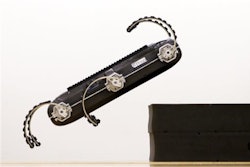In his approach to a potential investor, John McLear hired a calligraphist to write him a letter on parchment paper, a nod to the Lord of the Rings, and a creative way to present his own ring design. The unconventional approach succeeded, but in search of additional funding, McLear has turned to Kickstarter to help bring his equally unconventional product to market.
View: Kickstarter of the Week: One Ring to Open All Doors
The Near Field Communication (NFC) Ring looks like any other piece of jewelry, but has the ability to unlock doors, mobile phones, and can transfer information. McLear first came up with the idea to make an NFC enabled ring after installing a digital door lock to try and ease the stress on a family member who suffers with motor control (and a friend who comes back from the pub after a few too many on the weekends).
NFC is based on radio frequency identification (RFID) technology which makes communication with devices such as digital door locks possible. The NFC Ring can also be used to share WiFi information, links to websites, and contact information to smartphones and tablets.
The first prototypes were designed in Tinkercad and 3D printed in plastic. The next step was designing a metal ring; however, since the technology is radio based, incorporating it into a metal design was difficult.
“Combining metal and RFID was the biggest problem we faced when developing the ring. Naturally, metal absorbs the RFID signal from the antenna which means that induction fails and so does the ability to communicate with the ring,” McLear explains. To overcome this issue, McLear designed a RFID shielding that was thin enough to allow signals to travel through. The first shielding had a width of 12 mm, and while this was thin enough for communication, it made the ring bulky and uncomfortable. After five very expensive prototypes, McLear developed his own six millimeter NFC Inlay, resolving both issues of communication and aesthetics.
To continue reading the full article, click here to visit our partner publication, PD&D.























